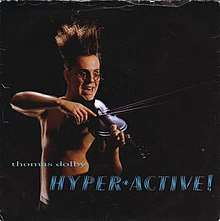Hyperactive!
"Hyperactive!" is a single by British musician Thomas Dolby, taken from his second album The Flat Earth, released in 1984. Additional vocals were provided by Louise Ulfstedt.[1]
| "Hyperactive!" | |
|---|---|
 | |
| Single by Thomas Dolby | |
| from the album The Flat Earth | |
| B-side |
|
| Released | January 1984 |
| Format | 7", 12" |
| Recorded | 1983 |
| Genre | Synthpop, new wave |
| Length | 4:46 |
| Label | EMI, Capitol Records |
| Songwriter(s) | Thomas Dolby |
| Producer(s) | Thomas Dolby |
| Music video | |
| "Hyperactive!" on YouTube | |
According to Thomas Dolby, he initially composed the song for Michael Jackson, whom he met in 1982. He decided to record it by himself since he never got any feedback from Jackson after sending him a demo tape.[2]
It was the first single to be taken from the album and peaked at #17 on the UK Singles Chart and #16 on the Canadian RPM Magazine charts,[3] but only reached #62 on the US Billboard Hot 100.
In 2017, the song was featured over the second episode closing credits of the FX series Legion.
Chart positions
| Chart (1984) | Peak position |
|---|---|
| Australia (Kent Music Report)[4] | 26 |
| New Zealand (RIANZ)[5] | 41 |
| Canada RPM Top Singles[3] | 16 |
| US Billboard Hot 100[6] | 62 |
| UK Singles Chart[7] | 17 |
| U.S. Billboard Dance/Disco Top 80[8] | 37 |
In other media
The song appeared in the 2002 video game Grand Theft Auto: Vice City on the fictional in-game radio station "Wave 103".
The song is used for the end credits music of episode 2 of Legion.
It appears in season 4, episode 9, Bug, of Breaking Bad.
References
- "MusicBrainz". Retrieved 5 April 2011.
- Record Collector, Issue 366/2009
- "RPM Magazine". Retrieved 26 September 2010.
- Kent, David (1993). Australian Chart Book 1970–1992. St Ives, NSW: Australian Chart Book. ISBN 0-646-11917-6.
- "Hyperactive!". charts.nz. Retrieved 1 April 2017.
- "Thomas Dolby - Chart History". Billboard.com. Retrieved 1 April 2017.
- "Thomas Dolby - Hyperactive!". Officialcharts.com. Retrieved 1 April 2017.
- Whitburn, Joel (2004). Hot Dance/Disco: 1974-2003. Record Research. p. 81.